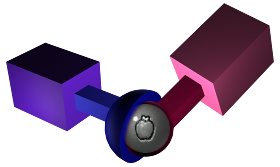phys_ballsocket

phys_ballsocket is a point entity available in all ![]() Source 2 games. A constraint that keeps the position of two objects fixed, relative to the constraint's origin. You can optionally specify limits for the relative twist and swing rotation.
Source 2 games. A constraint that keeps the position of two objects fixed, relative to the constraint's origin. You can optionally specify limits for the relative twist and swing rotation.
Keyvalues
- Name
(targetname)<string> - The name that other entities refer to this entity by, via Inputs/Outputs or other keyvalues (e.g.
parentnameortarget).
Also displayed in Hammer's 2D views and Entity Report.See also: Generic Keyvalues, Inputs and Outputs available to all entities
- Friction
(friction)<float> - Resistance/friction in the constraint
- Enable Swing Limit
(enable_swing_limit)<boolean> - Limit relative rotation away from the constraint's Z axis
- Swing Limit
(swing_limit)<float> - Maximum swing angle in degrees, if the swing limit is enabled
- Enable Twist Limit
(enable_twist_limit)<boolean> - Limit relative rotation about the Z axis
- Min Twist Angle
(min_twist_angle)<float> - Minimum relative twist angle in degrees, if the twist limit is enabled
- Max Twist Angle
(max_twist_angle)<float> - Maximum relative twist angle in degrees, if the twist limit is enabled
TwoObjectPhysics:
- Entity 1
(attach1)<targetname> - Entity 2
(attach2)<targetname> - The entities to constrain. Leave one or the other field blank to constrain to the world.
 Note:Only one entity will be constrained, even if several share the given targetname.
Note:Only one entity will be constrained, even if several share the given targetname. - Constraint System Manager
(constraintsystem)<targetname> - A
phys_constraintsystemthat this constraint should be a part of. This avoids the "jiggling" caused by constraints applied to the same set of entities fighting with each other. - Force Limit to Break
(forcelimit)<float> - Impact force required to break the constraint, in pounds. 0 means infinite. A way of calculating this is to set it to the weight of an object that would break the constraint if it were resting on its objects.
- Torque Limit to Break
(torquelimit)<float> - Torque required to break the constraint, in pounds*inches. 0 means infinite. A way of calculating this is to multiply any reference mass by the resting distance (from the center of mass of the object) needed to break the constraint.
- Play Sound on Break
(breaksound)<string> - A sound played when the constraint is broken.
- Follow teleport distance
(teleportfollowdistance)<float> - If one constrained object teleports more than this many units away, the other will teleport with it.
- Name
(targetname)<string> - The name that other entities refer to this entity by, via Inputs/Outputs or other keyvalues (e.g.
parentnameortarget).
Also displayed in Hammer's 2D views and Entity Report.See also: Generic Keyvalues, Inputs and Outputs available to all entities
Flags
No Collision until break : [1]
Start inactive : [4]
Change mass to keep stable attachment to world : [8]
Do not connect entities until turned on : [16]
Inputs
TwoObjectPhysics:
Break- Force the constraint to break.
TurnOn- Enable the constraint; do this if the constrained objects don't exist when it spawns. Note that broken constraints cannot be turned back on as they have been deleted.
TurnOff- Disable the constraint.
Outputs
TwoObjectPhysics:
OnBreak- Fired when the constraint breaks.
